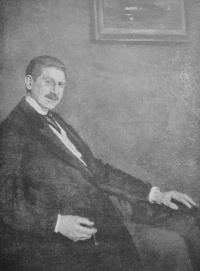Adolf Kohner
Among the artists represented in his collection were Théodore Géricault, Eugène Delacroix, Honoré Daumier, painters of the Barbizon school such as Jean-Baptiste-Camille Corot, Jean-François Millet, Antoine Chintreuil, Gustave Courbet, Édouard Manet, Berthe Morisot, Claude Monet, Pierre-Auguste Renoir, Paul Cézanne, Alfred Sisley, Paul Gauguin and Pierre Puvis de Chavannes.
Kohner used the earnings from his banking and other businesses to buy an estate of 28.000 acres near Szolnok, Hungary, with the goal of transforming it into a model farm and university study center.
Professors and students from the Agrarian University of Budapest used this land as an experimental laboratory and it ultimately became one of the most avant-garde farming system of all time.
In his memoirs Bartók recalled the help Kohner offered him in 1905 and he stated: "... he wanted me to understand that I could turn to him with confidence in case I needed money.
The home library was full of manuscripts... People talked about many topics: music, literature, Jewish issues, religion, Bolshevik movement, manufacturing, trade.
Mr. Baron is familiar with music, he plays the violin ... he is a close friend of some painters (the Kohner family loves Adolf Fényes very much.
In the early 1930s Kohner unsuccessfully engaged in financial speculation which had negative effects on his businesses and ultimately dragged him to the brink of bankruptcy in 1933.
Upon his death in 1937, his obituary, appearing in the journal Past and Future, stated that, despite the financial collapse that forced him to a retired life, Kohner had endured with dignity finding solace in his beloved books.
